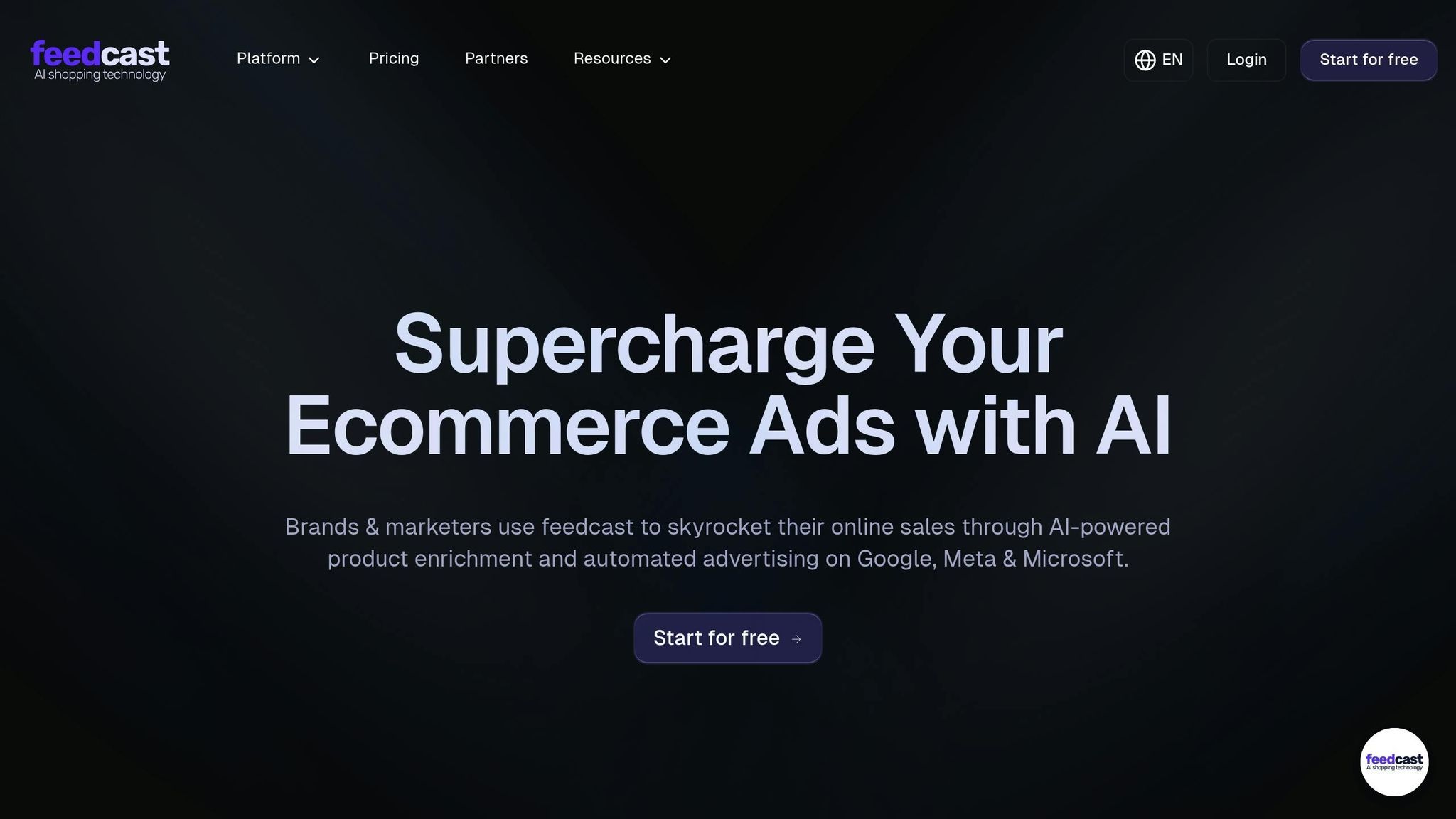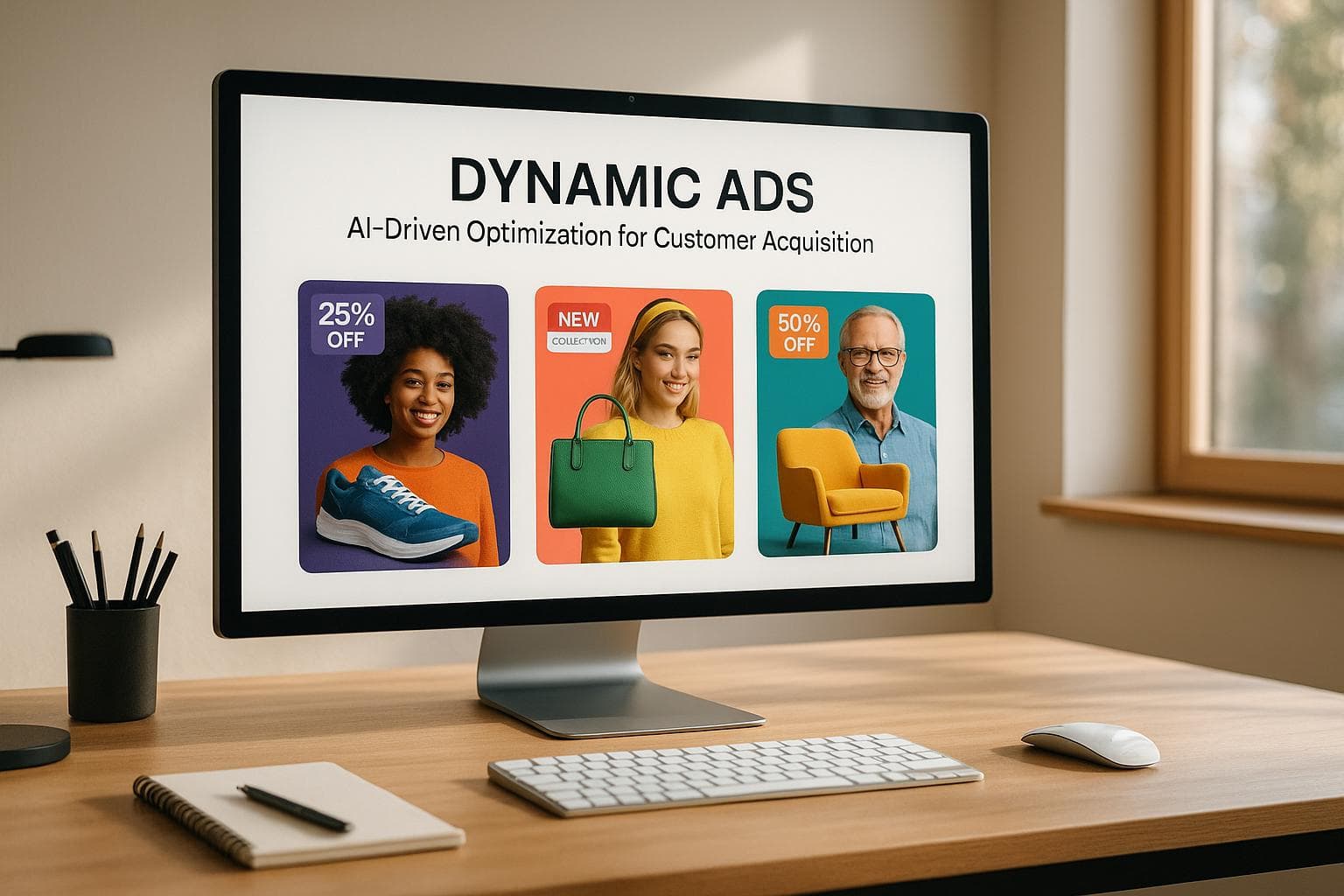AI-Powered Ads in a Privacy-First World
Explore how AI-powered advertising tools are reshaping digital marketing strategies while ensuring compliance with privacy regulations.
Digital advertising is changing fast. With stricter privacy laws like CCPA and GDPR, businesses must rethink how they target and engage users. Traditional ads - like TV, radio, and print - are losing ground due to high costs, limited targeting, and slow feedback. AI-powered tools, on the other hand, offer precise targeting, real-time adjustments, and compliance with privacy rules.
Here’s the key takeaway: AI-driven platforms like Feedcast.ai deliver better results at lower costs while respecting user privacy. These tools use anonymized data and contextual targeting, making them a smarter choice for businesses navigating today’s privacy-conscious landscape.
Quick Highlights:
- Traditional Ads: Expensive, broad targeting, manual processes, and limited flexibility.
- AI-Powered Ads: Cost-efficient, precise, automated, and privacy-compliant.
For businesses, the choice is clear: combining AI-powered tools with occasional use of traditional ads can maximize effectiveness while meeting modern privacy demands.
Data, Privacy, and the Future of AI in Digital Advertising
1. Traditional Advertising Methods
For decades, traditional media - TV, radio, print, and billboards - has been a cornerstone of building brand awareness. These channels focus on delivering static messages to large audiences, aiming to establish brand recognition and recall. But in today’s privacy-conscious digital world, these methods face distinct challenges that businesses must navigate carefully.
Compliance with Privacy Regulations
Traditional advertising has an advantage when it comes to privacy compliance. Unlike digital methods, it typically doesn’t rely on personal data collection. TV commercials, radio spots, and print ads don’t track individual user behavior or gather personal information, which naturally aligns with privacy regulations like CCPA and GDPR[3].
However, as traditional media ventures into digital spaces - like streaming TV, online radio, and digital magazine subscriptions - the lines blur. Advertisers in these areas must address the same privacy requirements as their digital counterparts[3].
Managing compliance in traditional advertising is largely a manual task. Unlike AI-driven platforms that automate privacy safeguards, businesses must ensure their campaigns meet regulatory standards on their own, especially when traditional media extends into digital formats. While this manual approach simplifies privacy compliance in some ways, it sacrifices the precision that comes with data-driven targeting.
Targeting Precision
Traditional media relies on broad demographic targeting, focusing on factors like age, location, and general interests[3]. For instance, a prime-time TV ad might reach millions of viewers, but advertisers have limited control over who within that audience sees the message.
This lack of precision can lead to inefficiencies. A radio ad targeting morning commuters in a specific city might reach the desired audience geographically, but it can’t distinguish between someone actively shopping for a product and someone who isn’t interested at all. Traditional targeting is based on assumptions about audience behavior, rather than real-time data about individual preferences[3].
The result? Higher waste in ad spend, as businesses often pay to reach audiences that have little to no interest in their offerings.
Campaign Efficiency
Traditional advertising campaigns come with hefty upfront costs and manual processes. Producing a TV commercial alone can range from $50,000 to $500,000, and securing a 30-second prime-time spot could cost over $100,000[4]. These expenses must be committed before any results or feedback can be assessed.
Every stage - creative development, media buying, and campaign management - requires hands-on coordination[4][1]. Once an ad goes live, it’s difficult (if not impossible) to make changes, leaving little room to adapt to market shifts or early performance feedback[2]. In contrast, digital campaigns offer flexibility and automation, allowing for real-time adjustments.
Measuring results in traditional advertising often relies on indirect metrics like brand recall surveys, sales lift studies, and media reach estimates[2]. Without the real-time insights available in digital campaigns, optimizing performance or pivoting strategies becomes a slower, more resource-intensive process.
Scalability
Scaling traditional advertising campaigns is resource-heavy and complex[1]. For instance, expanding a successful local radio campaign to a national audience requires purchasing additional media placements across multiple markets. This increases costs significantly without the cost-saving efficiencies seen in digital platforms.
Unlike digital advertising, where scaling can be automated and centrally managed, traditional campaigns require individual negotiations and management for each new market or outlet[1][3]. A business looking to transition from regional TV ads to national coverage must contend with varying pricing structures, audience demographics, and creative standards.
This manual scaling process often limits traditional advertising to larger companies with substantial budgets, leaving small and medium-sized businesses unable to compete effectively on a national level[1]. Digital platforms, by contrast, allow for seamless expansion through automation.
Despite these challenges, traditional advertising still delivers results for many businesses. For example, direct mail achieves a 29% median ROI, TV advertising delivers a 71% average ROI for established brands, and print ads offer an 80% ROI for local businesses[4]. However, these returns often include long-term brand-building benefits, making direct comparisons with the more immediate results of digital campaigns difficult.
2. AI-Powered Advertising Tools (e.g., Feedcast.ai)

AI-powered advertising tools are changing the game, moving away from the broad, static strategies of traditional media. These platforms use machine learning to create campaigns that adjust in real time based on user behavior and market trends - all while prioritizing privacy. Unlike traditional approaches that treat audiences as a monolith, AI-driven tools can manage thousands of audience segments at once, ensuring compliance with privacy regulations and delivering tailored experiences.
Compliance with Privacy Regulations
Operating in a privacy-first landscape, these tools are designed to meet stringent data protection standards like the California Consumer Privacy Act (CCPA). They achieve this by using anonymized or aggregated data instead of personally identifiable information. Techniques such as cohort-based targeting and contextual advertising ensure ads remain relevant without compromising user identities. Automation further strengthens compliance by applying privacy controls automatically and offering opt-out options as required by law. This focus on privacy doesn't just meet legal standards - it also builds trust while enabling precision targeting.
Targeting Precision
AI-powered platforms take targeting to a whole new level. Instead of relying on broad demographic guesses, they analyze extensive user behavior data to create detailed audience segments. For example, Feedcast uses machine learning to craft customized ad copy and refine targeting based on real-time performance data. Its AI-driven tools enhance product titles, descriptions, and attributes, ensuring better alignment between products and user searches. Over time, these platforms learn from performance feedback, continuously improving the effectiveness of campaigns. The result? Ads that connect with the right audience at the right time.
Campaign Efficiency
Efficiency is another standout feature of AI-powered advertising tools. Compared to manual processes, these platforms deliver impressive results. For instance, industry data shows that AI-optimized email campaigns achieve an average ROI of 42:1 (4,200%), while paid search campaigns see an 8:1 ROI, and social media campaigns can perform up to 95% better[4]. Feedcast simplifies campaign management by centralizing operations across major platforms like Google, Meta (Facebook and Instagram), and Microsoft Ads - all accessible through a single dashboard. Automation takes care of tasks like audience segmentation, bid adjustments, and error detection, reducing manual effort and speeding up optimization. With real-time analytics, businesses can monitor performance instantly and tweak strategies as needed. Plus, Feedcast offers a free tier for beginners, with paid plans starting at $99 per month.
Scalability
AI-powered platforms are built to scale effortlessly. Feedcast, for instance, supports businesses in managing thousands of campaigns without significant additional costs[1][3]. It allows product imports from e-commerce platforms like Shopify, WooCommerce, and PrestaShop, enabling seamless multi-channel campaigns from one interface. With the ability to manage up to 100,000 products in its Premium plan, Feedcast demonstrates how AI automation can handle growing product lines or expanding target markets without requiring proportional increases in resources. This scalability ensures that businesses can maintain high-quality campaigns, even as their operations grow.
sbb-itb-0bd1697
Pros and Cons
When it comes to advertising in today’s privacy-conscious world, businesses face a balancing act. Both traditional advertising methods and AI-powered tools bring their own strengths and weaknesses to the table. Recognizing these trade-offs is key to crafting a strategy that aligns with modern privacy standards and business goals.
| Criteria | Traditional Advertising Methods | AI-Powered Tools (Feedcast) |
|---|---|---|
| Privacy Compliance | ✅ Broad targeting simplifies compliance ❌ Manual processes can lead to errors |
✅ Automated controls align with CCPA/GDPR standards ❌ Complex data handling requirements demand careful management |
| Targeting Precision | ✅ Great for building broad brand awareness ❌ Lacks granular targeting |
✅ Data-driven strategies enable precise targeting ❌ Effectiveness depends on data quality and availability |
| Campaign Efficiency | ✅ Predictable workflows from established processes ❌ Labor-intensive with slower optimization cycles |
✅ Average 12.2% cost reduction and 10–30% ROI improvement ❌ Requires technical expertise for setup |
| Scalability | ✅ Proven performance on large campaigns ❌ Expanding often increases costs and complexity |
✅ Manages unlimited products with unified analytics across channels ❌ Initial integration may require upfront investment |
| Cost Management | ✅ Fixed budgets provide clarity ❌ Limited real-time optimization can lead to inefficiencies |
✅ Real-time optimization cuts costs (e.g., up to 20% on Google Shopping campaigns [5]) ❌ Performance tied to algorithm quality |
Traditional advertising thrives on its ability to connect with broad audiences emotionally, offering a sense of familiarity and stability. However, it often struggles with precision and agility in rapidly changing markets. Its fixed cost structures can simplify budgeting but may lead to inefficiencies due to limited real-time adaptability.
On the other hand, AI-powered tools like Feedcast are built for measurable results. With over 3,000 e-commerce brands already leveraging the platform [6], Feedcast delivers time-saving automation and detailed analytics across major channels like Google, Meta, and Microsoft Ads. Its scalability is unmatched - managing unlimited products while offering unified insights. Pricing starts at zero, with plans scaling to $99/month for up to 1,000 products and $249/month for up to 100,000 products, making it a flexible option for growing businesses.
That said, AI tools come with their own challenges. They rely heavily on high-quality data and require technical expertise to unlock their full potential. While Feedcast’s free starter option is appealing, businesses must invest in digital marketing skills to maximize its capabilities.
Privacy compliance is another area where the two approaches differ. Traditional methods rely on manual processes, which can be prone to errors, while AI tools automate compliance but require robust data governance to avoid pitfalls.
Conclusion
The advertising world has shifted toward privacy-first, AI-driven strategies, becoming essential for businesses aiming to thrive in today’s competitive digital space. While traditional advertising methods still play a role in emotional storytelling, platforms like Feedcast.ai bring unmatched precision and compliance to the table.
Current trends highlight this evolution, with marketers increasingly leaning on AI tools for sharper targeting and better results. These tools not only ensure privacy-compliant data usage but also align seamlessly with US regulatory standards, offering businesses a clear advantage.
For US e-commerce businesses, this means it’s time to rethink their advertising game plan. Traditional methods often require hefty upfront investments and lack the tracking capabilities needed for modern campaigns. In contrast, AI-powered solutions provide a scalable, cost-efficient alternative packed with advanced analytics.
Feedcast.ai simplifies advertising by consolidating campaigns across major platforms, offering real-time optimizations and automated compliance with privacy rules. This streamlined approach eliminates the manual work associated with traditional advertising while delivering better results at a lower cost.
The takeaway? US e-commerce businesses should make AI-powered tools like Feedcast.ai the cornerstone of their advertising strategy. By blending these tools with traditional methods for occasional brand storytelling, businesses can achieve the best of both worlds - data-driven precision and emotional connection. This balanced approach ensures compliance, efficiency, and the ability to build lasting customer relationships in an ever-evolving market.
FAQs
How does Feedcast.ai ensure compliance with privacy regulations like CCPA and GDPR while using AI-powered tools for advertising?
Feedcast.ai takes a privacy-first approach, ensuring it aligns with major regulations like the California Consumer Privacy Act (CCPA) and the General Data Protection Regulation (GDPR). The platform is built to prioritize both transparency and data security by following stringent rules for how data is collected, stored, and used.
With a focus on responsible AI use, Feedcast.ai limits reliance on personally identifiable information (PII). Instead, it works with anonymized and aggregated data to enhance ad performance. This not only helps businesses improve results but also strengthens user trust in an era of shifting privacy expectations.
What are the main benefits of using AI-powered ads compared to traditional advertising methods, especially for targeting and cost efficiency?
AI-powered advertising brings a new level of precision and efficiency compared to traditional methods. By leveraging advanced algorithms, these tools fine-tune targeting and help businesses cut down on costs. Platforms like Feedcast.ai make it even easier by automating ad creation and optimizing campaigns across major platforms like Google, Meta, and Microsoft.
With AI, businesses can tap into highly specific audience segments, making it easier to acquire new customers and re-engage existing ones. These tools also simplify managing product data, ensuring ads are more relevant and impactful. The result? Better performance and a stronger return on investment (ROI).
What level of technical expertise is needed to use AI-driven advertising platforms like Feedcast.ai effectively?
Feedcast.ai is built to be straightforward, so you don’t need to be a tech expert to dive in. Its easy-to-navigate interface and automated features make it a practical choice for businesses of any size - even those without an in-house tech team.
The platform takes the hassle out of tricky tasks like managing product feeds, crafting AI-enhanced ads, and monitoring campaign performance. By bringing these processes together in one place, Feedcast.ai lets businesses concentrate on scaling and strategy instead of getting bogged down in technical complexities.
Yohann B.










